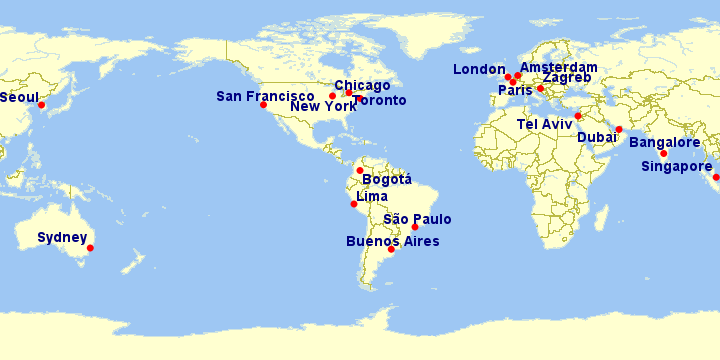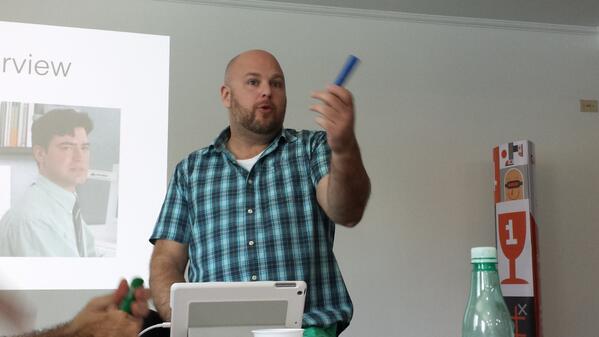GSummit Global 13: Gamification Around The World
In mid 2013 we embarked on an unusual, exhausting and time consuming project: GSummit Global. Our goal was to bring live gamification workshops, networking meetups and the best, new online lectures to key cities around the world. During the year, I traveled well over 100,000 miles, visiting over a dozen cities from Bangalore to Buenos Aires and everywhere in between.
This week we concluded the series with a sold-out workshop in South America’s largest city, and its financial capital: São Paulo. Over lunch with my fellow workshoppers, a question came up that I had heard time and again: how does the gamification industry here compare to the rest of the world? (n.b. I didn’t get this question at our US events). While there are no easy answers to this question, I thought I’d compile some of my thoughts and observations as they relate to this question.
Great meet up in Argentina with @gzicherm from @gamificationco #gamification It was a pleasure for us! @FilousLA pic.twitter.com/lQb2k1wrfP
— Alejandro Lang (@langalejandro) January 11, 2014
We Are More Similar Than Different
What I found consistently is that gamifiers are a unique breed of people. We are uniquely interested in human behavior and seem driven by a passion to solve serious problems. The folks that I met were consistently curious but also business-minded – our global community is filled with dreamers looking to have a sustainable, practical impact on the world around them. What I also saw often was a desire to make a mark: especially in these early days of gamification, many of the fiercest global advocates understand that success can help further their countries, companies and also their careers.
Awesome #gamification community chat with @gzicherm at @areatreslabs #buenosaires pic.twitter.com/oPQlVURrIC
— Mati Kalwill (@matikalwill) January 10, 2014
Our Problems Are Similar But Very Different
Broadly, gamifiers across the world were looking to address similar problems: employee engagement and disaffection, customer loyalty, student education, sustainability and political-cultural challenges. If they’re working on – say – a call center gamification problem in Brazil or in Budapest, the concerns, issues and dynamics are quite similar, and the inertia that needs to be overcome is comparable. But the cultures that govern our solutions, both as they give rise to the problem and constrain our solutions, are quite different.
In some countries for example, employees are already constantly monitored – while in others this is anathema. In the Middle East, customers willingly give any data for a discount, while Australians are more suspicious. Therefore it continues to be important that gamification experts the world over have access to great common resources (e.g. GSummit SF and the Gamification Database) while also having local knowledge and skills to solve the most intractable problems.

Market Maturity Is Vastly Different
Everyone who came to hear me speak – and certainly those willing to spend the money for a workshop – obviously represent a “leading edge” of the market. It’s therefore quite challenging to draw any conclusions about the state of the market purely from my interactions with these individuals. However, the size of the companies represented, and the seniority of their delegates, give us some sense of where the real corporate cultural waterline is.
For example, our Bangalore workshop was attended by some of the largest companies in India, rivaled for Fortune 1000 representation only by New York and San Francisco (no surprise there). Our London, Dubai and Amsterdam groups were filled with startups and government, while Singapore and Buenos Aires was heavily attended by government, quasi-gov and the education sector. Brazil, Tel Aviv, Dubai, Toronto and Sydney were a mix of high-growth startups, SMEs and some of the biggest brands in those regions. In every case, employee-focused projects outnumbered marketing projects by 2:1 approximately.
Another interesting bellwether for gamification’s entrenchment is the prevalence of “Head of Gamification” roles in major companies. Again, San Francisco, New York and Bangalore appear to be the major hubs, though Israeli companies had many real projects underway, and select entities (like the Dubai Police, for example) are very far ahead in their use of the approaches.
Regardless of exactly where each market lies, the opportunities have never been greater. Even in the US, gamification projects are only now really moving from test to recurring program with some regularity. In the rest of the world, the option to bring gamification to the table as a core part of the customer and employee engagement plan will create many new champions, embolden existing winners, and boost the fortunes of tens of thousands of individuals who will move our industry forward.
Thanks to everyone who attended live and online, the global partners and individuals who made GSummit Global possible and our intrepid team in NYC. As our focus shifts to GSummit SF (June 10-13), I hope to see many of these global achievers join us for 3+ days of amazing learning, networking and fun. See you all again soon.








